|
| |
Issue no. 19 - December 1984
pdf
 version of this
Issue version of this
Issue
|
There is much information in this issue that is valuable
and useful. Online readers are reminded, however, that treatment guidelines and health
care practices change over time. If you are in doubt, please refer to
WHO's up-to-date Dehydration Treatment
Plans.
|
Pages 1-8 Dialogue on Diarrhoea Online Issue 19 - December
1984
|
DDOnline
Diarrhoea Dialogue Online Issue 19 December
1984  Page 1 2
Page 1 2
ORT: the life-saving solution
Millions of children in developing countries die every year from dehydration due to
diarrhoea. Early use of oral rehydration salts (ORS) solution could save their lives.
Every family can learn to use oral rehydration therapy (ORT). The 'pull-out'
pages in this issue of DD answer many questions our readers ask about ORT. Correct in all situations
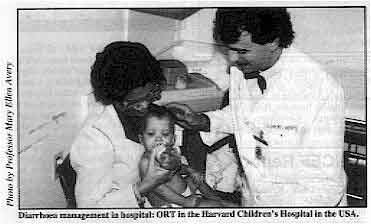 |
Diarrhoea management in hospital: ORT in the Harvard Children's
Hospital in the USA.
|
Developing countries have the biggest problem with diarrhoea but ORT is now recognized
as the correct treatment in all situations. Doctors anywhere who remain unconvinced should
note the words of Professor Mary Ellen Avery at the 1983 International Paediatric
Association's meeting in Manila: "We consider any child requiring intravenous
rehydration a failure of our basic diarrhoea management strategy".
Dr Avery is in charge of one of the largest paediatric centres in the United States;
the Harvard Children's Hospital. The same strategy can be applied anywhere, in the
simplest and also in the most difficult circumstances. The urgent food supplies being sent
to the Ethiopian famine areas also include thousands of packets of ORS. Encouragement for DD
|
Diarrhoea management at home: a Pakistani father giving
ORS solution to his child. As part of its follow-up to the International Conference on Oral Rehydration Therapy
(ICORT), held in 1983, the U. S. Agency for International Development is sponsoring the
expansion of the circulation of Diarrhoea Dialogue. The aim is to reach all those
who can use the newsletter and the mailing list of readers of the English edition has
already increased by 75 per cent. The Dialogue is translated into French,
Spanish, Arabic and Portuguese. Please help to expand the readership further by returning
the card inside this issue and sending extra names; requests for extra copies to
distribute locally and by letting us know which other language editions would be welcome.
|
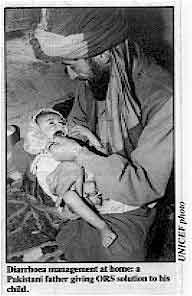 |
K.M.E. and W.A.M.C.
|
In this issue . . .
- ORT successes in Bangladesh, Haiti and Swaziland
- ORS - recent developments
- Teaching aids: slide-tape sets
|
|
DDOnline
Diarrhoea Dialogue Online Issue 19 December
1984  1 Page 2 3 1 Page 2 3
|
ORS: new formula gives longer shelf life
Packets of
oral rehydration salts (ORS) are now being distributed worldwide by UNICEF. Thirty-eight
countries are producing their own supplies. In hot, humid climates, especially where ORS
is being packed locally, packets may have only a short shelf life. This is because, in a
damp atmosphere, sodium bicarbonate reacts with glucose in the formula and the powder
becomes discoloured and less effective. For some time, the WHO Programme for the Control of Diarrhoeal Diseases (CDD) has been
researching into a more stable ORS formula. Laboratory tests have shown that this can be
achieved by replacing the sodium bicarbonate in the formula by trisodium citrate
dihydrate. Although the citrate is more expensive, it can be packaged in cheaper
materials, considerably reducing the overall cost of the packets. Where ORS is already
being produced locally, the production of ORS-citrate does not require any new equipment.
Recent clinical trials have also shown that, in addition to being more stable, the
ORS-citrate formula is at least as effective as the original formula in correcting
acidosis (1) and reducing stool Output. Although the new citrate formula is now being recommended by WHO and UNICEF, both
organizations are stressing that countries should not hesitate to continue to use
supplies of ORS-bicarbonate which is highly effective in treating dehydration. In late
1984, WHO will publish revised technical guidelines for the large-scale industrial
production of ORS-citrate. If you would like to receive this please write to The
Director, CDD/WHO, 1211 Geneva 27, Switzerland (1) Islam, M. R. et al, 1984. Oral rehydration therapy: efficacy of sodium citrate
equal to sodium bicarbonate for correction of acidosis in diarrhoea. Gut, 25, PP 900-904.
| ORS-bicarbonate |
grams/ litre |
ORS-citrate |
grams/ litre |
| Sodium chloride |
3.5 |
Sodium chloride |
3.5 |
Sodium bicarbonate
(sodium hydrogen carbonate) |
2.5 |
Trisodium citrate dihydrate |
2.9 |
| Potassium chloride |
1.5 |
Potassium chloride |
1.5 |
| Glucose, anhydrous |
20.0 |
Glucose, anhydrous |
20.0 |
|
ORT successes in Burkina Faso A village dispensary at Boassa, near Ougadougou in Burkina Faso (formerly Upper Volta)
is the site chosen by UNICEF for a recent test project on oral rehydration salts (ORS).
This dispensary, serving a population of about 50,000, has been run by Dominican Sisters
for seven years. During this time it has expanded to include a maternity unit and a
children's hospital - and it has gained the confidence of the local people. The success of
the ORT project is due to the approach taken by the Sisters. At the clinic, mothers with
dehydrated children are shown how to prepare and give the solution, rather than being
given a packet of salts to prepare at home with very little or no instruction. Mothers see
how the child has benefited from taking ORS solution before leaving the clinic, and are
then given another packet of salts, to take home with them to make up another litre. The
visible success of this treatment has also helped the Sisters to fight the traditional
belief that children suffering from diarrhoea should not be given liquids . . . . . . Further to the east, in Fada-N'Gourma, packets of oral rehydration salts are
being produced locally. The local product is called PRODIA and the packets are available
in the hospital at Fada-N'Gourma and at other health centres in the area. Regular and
consistent advice is given to health staff and mothers about the importance of oral
rehydration therapy and how to use the PRODIA salts. The PRODIA packets are formulated to
dissolve in half a litre of clean water. In bulk, 100 packets cost about $3.00 (U. S.).
All the ingredients for manufacture are bought locally except potassium chloride. It is
hoped that production and use of PRODIA can be extended throughout Burkina Faso to fight
the high infant morbidity and mortality rates due to diarrhoea. Jean-Mari Sawadogo and Dr Salifou Titamba Lakoande, Ministere de la Sante Publique,
B. P. 7002, Ougadougou, Burkina Faso. Portuguese DD A composite edition of Diarrhoea Dialogue, including material from issues 1-12,
is now available in Portuguese from AHRTAG, 85. Marylebone High Street, London W1M 3DE,
U, K. Media information The first of a series of Technical Reviews entitled 'Control of acute diarrhoeal
diseases in children' has been published recently by the International Children's
Centre in Paris. The booklet is aimed particularly at those working in the mass media, its
purpose being to provide them with information about the importance and success of ORT in
the fight against high infant mortality caused by diarrhoeal disease. Access to such
information is necessary if they are successfully to increase public awareness of the
problem. Available in Spanish, French and English from the ICC, Chateau de Longchamp,
Carrefour de Longchamp, Bois de Boulogne, 75016 Paris, France. UNICEF Report The central message of the 1984 State of the World's Children report is
a hopeful one - simple, inexpensive methods, including oral rehydration therapy, which
could revolutionize the survival and health of children in the developing world are now
available. The report also outlines the next major challenge: the need to put these
advances into practice. Available from Oxford University Press Showroom, 116 High
Street, Oxford OX1 4BZ, U.K. at £3.50.
|
|
DDOnline
Diarrhoea Dialogue Online Issue 19 December
1984  2 Page 3 4 2 Page 3 4
| ORT: the biggest campaign |
Teaching millions individually
In three years the Bangladesh Rural Advancement Committee (BRAC) has brought
information about oral rehydration therapy (ORT) to 2.5 million rural women. How has this
been achieved and what plans are there for the future? Shushum Bhatia
and William Cutting report. The Oral Therapy Extension Programme (OTEP) of BRAC has achieved its first objective of
individually teaching 2.5 million women in five of the country's 20 districts how to
prepare a home-made rehydration solution for diarrhoea. The ingredients used are available
in nearly every household: salt (lobon) and molasses (gur) which also contain some
potassium and bicarbonate. A three finger pinch of salt and a four finger scoop of
molasses are dissolved in half a 'seer' of water - a familiar local measure for 465 ml.
The International Centre for Diarrhoeal Disease Research, Bangladesh (ICDDR, B) has shown
this mixture to be effective for treating dehydration. Passing on this knowledge to more
than two million people in three years nevertheless presented an enormous task. Oral rehydration workers
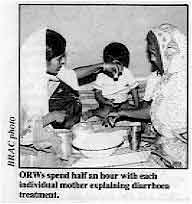 |
ORWs spend half an hour with each individual mother explaining
diarrhoea treatment.
OTEP uses teams of oral rehydration workers (ORWs). These travel systematically through
districts, visiting mothers door-to-door. The most striking feature of the programme is
the individual teaching. Every mother has a half-hour session with one of the female
ORWs.
After first building up an understanding with the mother, the ORW introduces seven points
explaining diarrhoea treatment. She invites questions to remove any doubts.
|
|
An ORW watches a mother makeup the rehydration solution using
lobon and gur, to make sure that she understands what she has been taught. Surveys have
shown that 98 per cent of mothers have learnt to prepare the home-made oral rehydration
solution correctly, and understand how and when to give it.
Mothers are taught that it is a mistake to stop giving food and drink to try to 'dry
up' the child as this only increases the danger of dehydration. When the woman understands
the treatment message, the ORW shows her how to prepare the lobon-gur and then watches as
the woman makes up the life-saving solution herself. After again checking that the mother
fully understands the seven points, the interview is over.
|
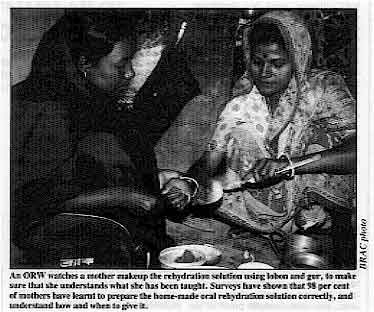 |
Monitoring team One month after the ORWs have left the area, a small monitoring and reinforcement team
surveys five per cent of the households visited to collect samples of the home-made oral
rehydration solution and to ask mothers how many of the seven points they can
remember. So far the surveys have found that 98 per cent of the women can prepare the
home-mix correctly and over 90 per cent remember all, or almost all, of the seven points.
This success may be partly because the ORWs are paid on a sliding scale, according to how
well the village mothers remember the seven points. It is clear from watching the ORWs at
work that they are sympathetic, capable and enthusiastic and have developed several
innovative ways of teaching the mothers. The challenges before the programme now are how
to expand and cover the whole of Bangladesh by 1986, and how to increase the confidence of
parents so that they will both know about and also use this life-saving treatment. BRAC, 66 Mohakhali Commercial Area, Dhaka 12, Bangladesh.
|
|
DDOnline
Diarrhoea Dialogue Online Issue 19 December
1984  3 Page 4 5 3 Page 4 5
| Accepting ORT: reports from Haiti and Swaziland |
Programming on a shoestring Over the past two years, by using rehydration therapy at all levels of the health
care system, Haiti has reduced deaths from diarrhoea and shown that universal primary
health care is possible even with limited resources. Jon Rohde
reports. In spite of incomplete health records, diarrhoea is known to be associated with
approximately half of infant deaths and 40 per cent of deaths occurring in the under-fives
in Haiti. Children with diarrhoea occupy one third of the few available paediatric
hospital beds. Before the introduction of oral rehydration therapy, an alarming number of
those with severe dehydration died, largely due to late referral. Although oral
rehydration therapy was introduced in Haiti in the mid 1970s, it was neither widely
accepted nor generally available to the public. Both health professionals and lay persons
could not believe that such a simple solution could be effective against the country's
biggest killer. Acceptance of ORT The establishment of a Rehydration Unit in the University Hospital in Port-au-Prince in
1980, and the subsequent decline in case fatalities from more than 30 per cent to less
than one per cent, provided dramatic proof of the efficacy of ORT. Not only did mothers
bring their children to receive treatment earlier, but their direct involvement in the
child's care whilst in hospital led to early home use of ORT in the community served by
the hospital, with a consequent reduction in the number of cases requiring referral for
expensive intravenous and nursing care. Staff participating in research activities in the
Unit demonstrated both the effectiveness of ORT and the ineffectiveness of antibiotics and
other anti-diarrhoeal preparations previously commonly used by the medical profession.
During 1982, staff from the fifteen rural district hospitals in Haiti were invited to
spend one week in the rehydration unit, caring for patients and participating in
discussions on patient management and the results of various research studies. On
returning to their own hospitals, they established similar units on a smaller scale to
serve patients and provide local training sites for rural health personnel. That same
year, diarrhoeal disease control was declared national health priority number one, and all
levels of the Health Ministry were called upon to focus efforts on universal
implementation of oral rehydration. A detailed national plan was prepared and each region
put forward its implementation proposals. During the course of a year more than 2,500
health workers were re-trained, through seminars and practical experience in district
hospitals. Supplying ORS packets
Recognizing that recurring costs of primary health care had crippled many previous
efforts by the Health Ministry to provide programmes in the rural area, supplies of
packaged ORS, manufactured in Haiti by a national firm, were distributed to the districts,
with the initial consignments to be sold at a nationwide fixed price of 15 cents per
packet (enough to make up one litre of ORS solution). To assure the availability of ORS
throughout Haiti, each of the 250 health establishments was encouraged to set up selling
posts within the local community. Village stores, traditional healers, community leaders,
police and army posts, teachers and volunteers were recruited to stock ORS packets, a
painted sign and colourful poster marking the site of each post. These selling posts were
provided initially with 50 packets, and the authority to purchase further supplies at 10
cents per packet - the 5 cents mark-up is their only compensation for providing the
service. Within one year, some 2,000 community selling posts were functioning. Promoting ORT
A countrywide campaign to promote ORT was undertaken with two main components: the
media, and the training and involvement of all members of the community.
- Media:
- a commercial firm was invited to prepare a multi-media campaign promoting the message
that ORT saves lives.
- in July 1983, the President initiated the publicity campaign in a nationally televised
Oral Rehydration Day.
- radio messages, coloured posters, brochures and leaflets were used to spread the message
about ORT.
- Community involvement:
Strong political support at the highest level reinforced the call to all sections of the
community to participate in the campaign. School teachers, agricultural extension workers,
the police and army, and traditional healers were trained in one-day sessions during
routine meetings in district headquarters or at village gatherings.
Success of the campaign
- Within six months of the campaign, knowledge of ORS had increased from 5 per cent to
almost 50 per cent in rural areas, and far above that in urban areas.
- Oral rehydration has become standard treatment for diarrhoea in clinics, hospitals and
private practices in Haiti.
- Health workers at all levels began to participate more fully in an improved monitoring
and reporting system as they saw the impact of their efforts on mortality. For the first
time, the majority of health establishments sent their monthly reports to district level
to be forwarded on to national level. Quarterly reports document the sale of packets,
numbers of personnel trained and the reduction in case fatalities.
A formal evaluation will be carried out in late 1984 or early 1985. Only then will the
impact on mortality, particularly in rural communities, be clear. Health for all Having planned, implemented and monitored a programme on a national scale, the Ministry
of Health is extending this strategy to other priority areas in primary health care. The
immunization programme will be expanded during 1984, and in 1985 efforts will be focused
on the detection and treatment of tuberculosis. Introduction of oral rehydration therapy
has not only provided effective treatment of diarrhoeal disease, but perhaps more
important, has established a model for universal coverage of primary health care services. Dr Jon Rohde, Management Sciences for Health, P.O. Box 2560, Port-au-Prince,
Haiti.
|
|
DDOnline
Diarrhoea Dialogue Online Issue 19 December
1984  4 Page 5 6 4 Page 5 6
| Accepting ORT: reports from Haiti and Swaziland |
Discovering oral rehydration therapy
The Minister of Health for Swaziland describes his personal discovery and
acceptance of oral rehydration therapy, and the adoption of ORT as a national health
priority. "As Minister of Health in Swaziland for the last five years, I have shared my
discovery of oral rehydration therapy (ORT) with health personnel at all levels from our
three paediatricians to our rural health motivators. Happily, ORT is now practised
throughout the country and we feel we have an answer to the biggest killer of our
children. This was not always the case, and acceptance of ORT has been a gradual process. For 27 years, I worked in a rural hospital, as a Medical Officer and then as a
Superintendent, where we tried every method we knew to treat dehydrated children. This
included setting up a 'filling station' unit where nurses became adept at finding scalp
veins for intravenous infusion. We knew that there must be a better way to both prevent
and treat dehydration, but although I had heard of oral rehydration therapy and had sent
away for some plastic measuring spoons, it was not until I left the hospital to begin a
private practice that I really discovered ORT. Having just started up the practice we had
no intravenous equipment or naso-gastric tubes and could not find the plastic spoons. But
every day mothers arrived, bringing their dehydrated children who needed immediate
treatment. After discussing the problem, my wife, a former Nursing Tutor, and our three
nurses decided that the only way we could deal with the situation was to use oral fluids. A miracle occurs
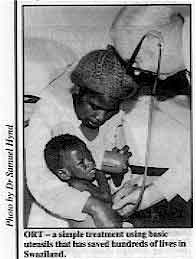 |
ORT - a simple treatment using basic utensils that has saved
hundreds of lives in Swaziland.
We had one packet of UNICEF oral rehydration salts which we mixed up in a litre bottle
of water. A nurse sat down with a cup and spoon to give the fluid to the child, with the
mother watching anxiously. Within three hours a miracle had occurred, the child was alert,
and everyone, including myself, was very impressed. Since then we have seen hundreds of
infants restored to health at the clinic, using the same simple treatment and basic
utensils. Oral rehydration therapy is now the obvious and immediate treatment; the nurses
give fluids to dehydrated children as soon as they arrive at the clinic.
|
Every mother bringing a child to us watches the mixing of the fluid and sits and gives
it to the child with a cup and spoon. She therefore knows what to do at home early on to
prevent dehydration if the child has diarrhoea again. We have found that nearly every home
in Swaziland has a litre Schweppes bottle that can be used to measure the correct amount
of water for oral rehydration solution. Promoting ORT in Swaziland Much of the unacceptably high infant mortality rate in Swaziland (156 per 1,000 births)
is due to diarrhoea-related deaths. Therefore an extension of the use of ORT is essential.
Many of our health workers have attended workshops at home and overseas about diarrhoeal
disease prevention and control, and there is a growing awareness of the need for ORT and
of its efficiency in preventing and treating dehydration. People are beginning to
understand that witchcraft is not the cause of diarrhoea in children, and that a simple
treatment will save them. Encouragement from USAID on media health promotion, information
dissemination through publications such as Diarrhoea Dialogue and involvement from
the international community, together with the motivation of our own health workers, are
all contributing towards progress in the use of ORT in Swaziland that will save many lives
in the future." Dr Samuel W Hynd, Minister of Health, Swaziland.
|
|
DDOnline
Diarrhoea Dialogue Online Issue 19 December
1984  5 Page 6 7 5 Page 6 7
Audio-visual materials
Practical teaching aids are invaluable in primary health care. They can be used to
convey health information to audiences at all levels. This page describes some useful
slide-tape sets about diarrhoeal diseases. Other forms of teaching aids will be discussed
in later issues of Diarrhoea Dialogue. The sets described below have been developed for training doctors, nurses and public
health workers and include the causes, prevention, clinical management and control of
diarrhoeal diseases. They are particularly helpful for those involved in planning
diarrhoeal disease control programmes within a framework of basic health care services at
community, district or regional level. 1. The Department of Tropical Hygiene, London School of Hygiene and
Tropical Medicine (with the Save The Children Fund) has produced a
package of information materials on the prevention and control of diarrhoea that includes
two slide-tape sets, an illustrated handbook, an information chart on diarrhoea and a
video-tape incorporating material from both slide-tape sets. This comprehensive package is
aimed primarily at doctors and nurses responsible for organization of health services. The
first set explains why diarrhoea is a major public health problem in the developing world,
drawing on examples from various countries. The second set describes effective
interventions for the control of diarrhoea. The hand-book reviews and develops the main
themes from both sets. For further details write to Dr Isabelle de Zoysa, Department
of Tropical Hygiene, London School of Hygiene and Tropical Medicine, Keppel Street, London
WC1E 7HT, U.K. 2. The National Diarrhoeal Diseases Control Project in Egypt has
produced a slide-tape set for teaching that contains 35 slides and last for 45 minutes.
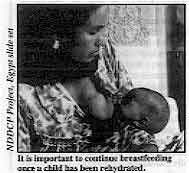
|
It is important to continue breastfeeding once a child has been
rehydrated. Although the slides focus on problems in Egypt, they are equally applicable elsewhere
and each slide has an explanatory note. The main message of the set is oral therapy - both
rehydration and continued feeding - and it is aimed principally at doctors. For further
details write to Dr N Hirschhorn, National Control of Diarrhoeal Diseases Programme,
20a Gamal el Din Abul, Mahassen Street, Garden City, Cairo, Egypt.
|
3. Teaching Aids at Low Cost (TALC) have produced a range of
slide-tape sets.
|
Drugs are not necessary to treat dehydration cased by diarrhoea.
One of these is called Diarrhoea Management: the practical application of recent
advances in diarrhoeal disease management. It is a small, low cost set that
can either be used as a teaching sequence or to make specific points. Extra slides of
local people can be put into the set by the user to make it more locally acceptable. This
is more difficult with the larger and more integrated sets. For further details write to TALC,
P. O. Box 49, St Albans, Herts, AL1 4AX, U. K.
|
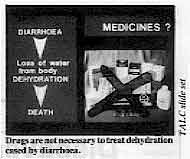 |
4. UNICEF New Delhi has produced a large and impressive
slide-tape set on diarrhoea management called A Simple Solution.
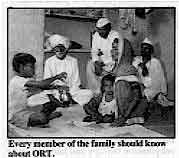
|
Every member of the family should know about ORT.
UNICEF New Delhi slide set Although the setting is India, the principles of diarrhoea programme management are
universally applicable. The set will be particularly valuable throughout the Indian
subcontinent. For further details write to UNICEF Regional Office for South Central
Asia, UNICEF House, 73 Lodi Estate, New Delhi 110 003, India.
|
Postage stamps are one of many ways of conveying messages
about diarrhoea as part of a public health education campaign. |
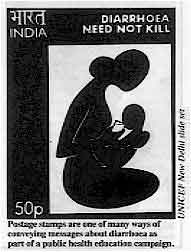 |
|
|
DDOnline
Diarrhoea Dialogue Online Issue 19 December
1984  6 Page 7 8 6 Page 7 8
Advances with rice-powder ORS
A Diarrhoea Dialogue interview with a leading doctor and research worker at the
International Centre for Diarrhoeal Disease Research, Bangladesh, Dr Majid
Molla. Dr Molla, why are you now using rice-powder instead of sugar or glucose in the oral
rehydration salts (ORS) to make a solution which you use to treat diarrhoea?
In our studies we have found that rice-powder is better than sugars in several ways.
First, as the traditional food in every home in Bangladesh and most South Asian countries,
rice is both available and familiar, and is therefore more acceptable to patients. The
rice-powder fluid is more of a food. It contains much more energy (or calories) and other
nutrients than ORS solutions which contain glucose or sucrose. Best of all, it is more
effective (1). The mixture has been shown to reduce the volume of stool in acute cholera
cases by 40-50 per cent and therefore reduces the amount of fluid which has to be drunk by
almost half (2). There is also less vomiting with rice-powder solution than with ORS
solution. Altogether it is a definite advance in treatment. What is the difference between rice-water and rice-powder ORS? We must be very clear about the difference. Rice-water is the fluid drained from rice
after cooking, and although this can be used as early home therapy, the amount of fluid
may be quite small. The composition is also generally unsuitable for active rehydration
because it contains very little salt and a variable amount of rice starch (3). Rice-powder
ORS solution is a fluid in which the glucose in the ordinary WHO/UNICEF formulation has
been replaced by a standardized amount of rice-powder, giving the correct balance of
carbohydrate and electrolytes. At present, packets of electrolytes without glucose are not
generally available and much more work and education will be needed before rice-powder ORS
could be part of an operational programme. How much rice-powder should be used and how do you make up the rehydration drink? We have experimented with different amounts and the treatment is effective with a range
of concentrations. We recommend 50g of rice-powder cooked in a little more than a litre of
water for 5-7 minutes with frequent stirring. Then the other ingredients (the electrolyte
salts) of ORS can be mixed in. What sort of rice should be used and how should you grind it?
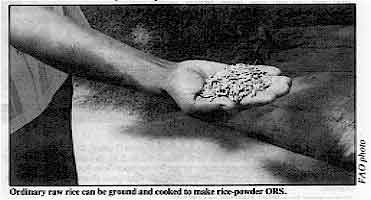 |
Ordinary raw rice can be ground and cooked to make rice-powder ORS.
Roasted or puffed rice can also be used, but ordinary raw rice is the cheapest and most
available. This can be ground before cooking in either a mechanical flour mill or using
traditional kitchen grinding stones.
|
How much rice-powder ORS fluid should be given to a child with diarrhoea? The same amount as you would give of glucose ORS solution. This depends on the size of
the child and the severity of the diarrhoea. For example, to replace what has already been
lost in a mildly dehydrated child, 50 ml per kg body weight should be given. For a child
weighing 10 kg this would be 500 ml over four hours. (See also the treatment tables in theinsert in this issue of Diarrhoea Dialogue.) How long can you keep and use a rice-ORS solution once you have made it up? It should be protected from contamination like any other food and drink. Our
preliminary findings suggest that it can be kept safely for about 8 hours in a hot
tropical climate and up to 24 hours in a colder climate. Can other cereals be used instead of rice for making up such rehydration mixes? Experiments are being carried out using wheat, maize, millet, sorghum and potato as
alternative sources of carbohydrate. It is still too early to recommend any of these, but
we at ICDDR, B are very confident that, in many countries, rice-powder ORS is the most
effective and appropriate treatment for diarrhoea. Before rice-ORS can be recommended for
small infants, there is a need to study its use in those under 3 months of age. 1. Patra et al, 1982. Is oral rice electrolyte solution superior to glucose
electrolyte solution in infantile diarrhoea? Archives of disease in childhood, vol 57, no.
12, pp 910-912.
2. Molla A M et al, 1984. Rice-based ORS decreases stool volume in acute diarrhoea.
Bulletin of WHO, in press.
3. Molla A M et al, 1984. Rice water is not rice cereal oral rehydration solution.
Lancet, 2, 40.
|
|
DDOnline
Diarrhoea Dialogue Online Issue 19 December
1984  7 Page 8 7 Page 8
Portuguese DD in Africa I am a physician working within the MCH services in Bissau, Guinea-Bissau. As in so
many other countries diarrhoea is a serious problem. Generally speaking, the knowledge of
ORS is relatively well spread in the Bissau urban population and many rural areas. Also,
traditionally people use "maberete" (rice water), leaves of the guava tree and
"cabacera" (Adansonia digitata) to counteract the diarrhoea. I have been regularly receiving your DD which I have found informative and
stimulating. Here in Guinea-Bissau the official language is Portuguese. As I have read
that you plan to launch a Portuguese version of DD I am interested to know when
you plan to publish the first Portuguese version, so that we in Guinea-Bissau would
benefit from this positive step right from the beginning. Also, I would like to know where
to obtain the Portuguese version. Dr Geir Gunnlaugsson, c/o Embaixa da Suecia, C. P. 252, Bissau, Guinea-Bissau, West
Africa. Note: see="#page2">news page.
Making soap in Bangladesh
In="dd18.htm">issue 18 of Diarrhoea Dialogue I noted with interest
an article relating handwashing to reducing the rate of diarrhoea attacks. One of MCC's
projects here in Bangladesh is a soap factory owned and operated by poor women. In
addition to providing income for the women, one of the objectives of the project is to
provide a relatively cheap but effective soap for rural use.
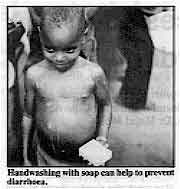 |
Handwashing
with soap can help to prevent diarrhoea.
In the past some health organizations have told us that they think there is a strong
correlation between the lack of handwashing and diarrhoea, but that since there is no real
evidence to support this assumption they have not included soap and handwashing as a major
part of their programmes. If there are now published reports the women at the soap factory
could use these as part of their sales strategy, consequently increasing their income and
reducing diarrhoea among the soap users.
|
Douglas Dirks, Job Creation Administrator, Mennonite Central Committee, Box 785,
Dacca-2, Bangladesh. Reference: Feachem R. G. Bulletin of WHO, 61.1,1984
Can you help? We are writing to ask advice from your readers. We have been requested by the World
Health Organization to prepare a document concerning feeding during and after diarrhoea.
This is mostly related to acute diarrhoea in the weaning period, but not exclusively so.
We would greatly appreciate it if readers with information on foods traditionally
recommended or avoided during and after diarrhoea could send this to us. In particular,
references would be greatly welcomed and we would, of course, be very pleased to
acknowledge the source of such information. Dr Derrick B. Jelliffe, Head, Division of Population and Family Health, School of
Public Health, Center for the Health Sciences, University of California, Los Angeles, CA
90024, USA.
Diarrhoea in the U. S. A. Please let me know how I can subscribe to your publication Diarrhoea Dialogue. I
am a general paediatrics fellow engaged in research in acute and chronic diarrhoea in
migrant farm workers (mainly Latin American and Haitian) here in North Carolina. Many
thanks. Dr Dana G Ketchum, Duke University Medical Center, Division of General Paediatrics,
Box 3937, Durham, North Carolina 27710, USA.
DD for schools I am a 16 year old boy, a senior student at Palawan National High School. I am one of
the staff of the Palawanian, our school paper. As an exchange editor I read many articles
from which I can get ideas to put in our paper that will benefit lots of students and
teachers. In my researches I've found out that Diarrhoea Dialogue is very
educational and informative. I always use it even though I borrow it from the library one
kilometre from our home. I would like to have a copy whenever there is an issue and I
would be glad if you could add my name to your mailing list to receive Diarrhoea
Dialogue and any other publications or reading materials that can enrich our knowledge
about diarrhoea and other illnesses. One more thing, I'd like to have some friends
anywhere through correspondence. Noel Honaria Daganta, 97-6 Magtonong Street, Puerto Princesa City,
Palawan,
Philippines 2901.
|
| In the next issue... DD 20 will
look at research at a practical level, including a field study from Zimbabwe. There will
also be advice on selecting, designing and carrying out projects. |

Scientific editors Dr Katherine Elliott and Dr William Cutting
Executive editor Denise Ayres
Editorial assistant Kathy Attawell
Editorial advisory group
Professor David Candy (UK)
Dr I Dogramaci (Turkey)
Professor Richard Feachem (UK)
Dr Michael Gracey (Australia)
Dr Norbert Hirschhorn (USA)
Professor Leonardo Mata (Costa Rica)
Dr Mujibur Rahaman (Bangladesh)
Dr Jon Rohde (USA)
Ms E O Sullesta (Philippines)
Professor Andrew Tomkins (UK)
Dr Paul Vesin (France)
Dr M K Were (Kenya) With support from AID (USA), UNICEF and WHO
|
Issue no. 19
December 1984
Page Navigation
This edition of Dialogue on Diarrhoea Online is produced by Rehydration Project. Dialogue on Diarrhoea was published four times a year in English, Chinese, French, Portuguese, Spanish, Tamil,
English/Urdu and Vietnamese and reached more than a quarter of a million readers worldwide. The English edition of Dialogue on Diarrhoea was produced and distributed by Healthlink Worldwide. Healthlink Worldwide is committed to strengthening primary health care and
community-based rehabilitation in the South by maximising the use and impact
of information, providing training and resources, and actively supporting
the capacity building of partner organisations. - ISSN 0950-0235 Reproducing articles
Healthlink Worldwide encourages the reproduction of
articles in this newsletter for non-profit making and educational uses. Please
clearly credit Healthlink Worldwide as the source and, if possible, send us a copy of any uses made of the material.
|
updated: 23 August, 2019
|